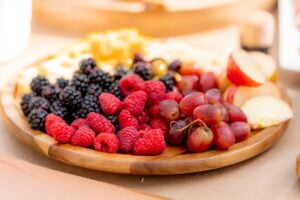10 MONTH BABY FOOD : FEEDING IDEAS
- Published on:
- Last update: 13 November 2023

BABY FOOD IDEAS FOR 10 MONTH OLD
You may notice that your baby has few teeth, can swallow food more easily, and has started sitting with confidence. As such, 10 months is the best time for introducing 10 month baby food or most of the family’s food products in the form of minced or chopped food, except for salt, sugar, honey, and cow’s milk.
You shouldn’t force the baby to eat, though, because every baby is different and adapts to certain eating habits differently. Make sure to continue encouraging his eating habits with all your strength. Make sure to continue offering finger foods and spices to him as you did during the nine-month period.
You should always remember that solid food can’t replace the nutrients breastmilk and formula provide to a child in their first year. Thus, you may want to include solids in your baby’s diet as a complement to breastfeeding. For your baby, it is recommended that homemade foods are always preferred.

In the first year, solid food cannot replace the nutrients that have been provided by breastmilk and formula. You may, therefore, consider adding solids to your baby’s diet as a complementary feeding. You should always choose homemade foods for your baby since they are safe.
- Fruits: A wide variety of fruits, excluding citrus fruits
- Vegetables: all seasonal vegetables
- Cereals & Grains: Almost all grains and cereals
- Pulses: Yellow Moong Dal, Masoor Dal, Chickpeas (White and Black) Chana, Urad Dal, Green Gram, Toor Dal, Bengal Gram Dal, and Soybeans
- Dairy: any dairy product except cow’s milk
- Non-Vegetarian: Egg yolks, chicken mince, seafood
- Spices: Turmeric, garlic, ginger, asafoetida, cumin seeds, pepper, coriander seeds, fennel seeds, caroms, fenugreek, mustard seeds, cinnamon, nutmeg, cardamom all can be added in little amounts, say a pinch.
Make sure the 10 month baby food is well balanced in terms of nutrients.
BABY IS ALMOST 10 MONTHS OLD: HOW MUCH FOOD DOES BABY NEED?
During the first 10 months of a baby’s life, you can offer three meals a day and a light snack, such as finger food, which can be offered anytime. You should feed your baby only by breastfeeding or formula feeding. Make your meal and snack timings according to the preferences of your baby.

WHAT IS THE QUANTITY PER DAY FOR A BABY?
Always follow your baby’s appetite when deciding on food quantity, as appetite changes from baby to baby, and most babies change daily. You can estimate a certain amount of food:
- Cereal – 1/4 to 1/2 cup
- Vegetables – 1/4 to 1/2 cup
- Fruits – 1/4 to 1/2 cup
- Dairy – 2 to 3 tbsp
- Meat/Protein – 4 tbsp
It’s best to introduce one food at a time and follow the “three-day rule” which will help you find out whether you are allergic to a particular food. Keep an out for allergy-triggering food when choosing 10 month baby food.
NOTES:
In a vessel filled with boiling water, immerse the bowls and spoons you are using for feeding your baby for five minutes, then put them back in the same container for use.
As some of the recipes are family recipes, some of the ones above are prepared with additional spices. Depending on your baby’s tastes, you can adjust the ingredients.
If you are introducing solid foods to your baby, you should never introduce more than one food at a time.
Sugar, salt, milk, and honey should not be included in your baby’s food until he or she turns one.
If you notice any symptoms of an allergy when you introduce a new food to your baby, you should stop feeding him or her.
You can feed your baby breast milk or formula milk on demand.
If your child is introducing a new food, make sure to consult your pediatrician first.
Compared to pressure cooking, steaming provides a healthier alternative for baby food. Using a steamer or Idli pot is therefore my preferred method of steaming.
WHEN CAN MY BABY JOIN IN WITH FAMILY MEALS?
As her digestive system is still developing, your baby won’t be ready to eat everything you can eat at 10 months. Prepare 10 month baby food that is suitable for the child. Nonetheless, she can still be a part of family meals, provided that you do not provide any of the following:
Honey: It contains bacteria that can sometimes cause infant botulism, a rare condition. Honey is also a type of sugar, which can be damaging to your baby’s developing teeth.
Raw, runny, or under-cooked egg: Eggs should always be cooked thoroughly so that they are both firm to the touch.
Low-fat and low-calorie foods: The foods you are recommending won’t provide your baby with enough energy, so they won’t meet her needs. Low-calorie and low-fat foods can also contain other additives and ingredients that may not be suitable for babies and toddlers.
Whole nuts: Whole nuts should not be given to your child until she is five years old, due to the risk of choking. Nuts and nut butter that is powdered and well ground are fine.
Salt: Don’t add extra salt to your baby’s food because it can harm her kidneys. Your baby should also be limited in the number of salty foods they consume, such as namkeens, chips, cheese, sausages, and processed meats. Prepared foods like sauces and cereals can contain surprisingly high amounts of sugar, so read the labels before giving them to your child. Those under one year old should consume less than 1 g of salt each day (0.4 g of sodium).
Sugar: Sugary foods and drinks can cause your baby’s teeth to decay, and they may also encourage a love of sweets. Rather than sugar, you can add fruit purée or raisin purée or your baby’s usual milk to sweeten the food.
Some types of fish: The nervous system of your baby may be affected by high mercury levels in sharks, swordfish, and marlin. Please do not feed your baby raw shellfish, as this may cause food poisoning.
Saturated fat: Fried foods, pakodas, chips, namkeens, biscuits, and cakes contain high levels of saturated fat. These foods sate your baby without providing much in the way of vitamins, so it’s best to stay away from them. As long as your baby is growing well along her growth curve, she also won’t need extra ghee, butter, or fats.
10 MONTH BABY FOOD: NOTES
Aside from these foods, your baby can share the same meals as the rest of the family. She’ll love having the same as you and seeing you enjoy a range of foods may help her to be a more adventurous eater. See our article on eating with the family for some interesting recipes.
Of course, this doesn’t mean that the rest of the family has to eat bland food. If family members prefer more salty or spicy meals, just take out a separate portion for your baby before adding seasoning to the food. Learn more about how and when to introduce spices in your baby’s diet.
You’ll notice your little one’s getting better at feeding herself all the time, too. At 10 months, she’s probably trying to feed herself with a spoon, though she’s unlikely to manage it just yet. See if your baby can handle 10 month baby food.
Help and encourage her by letting her hold on to her own spoon as you feed her with another one. Give her plenty of finger foods as well, to give her the chance to experiment with feeding herself.
Reference: Food I Feed My 10 Month Old
Share this post:

